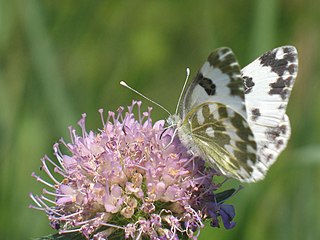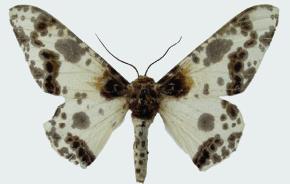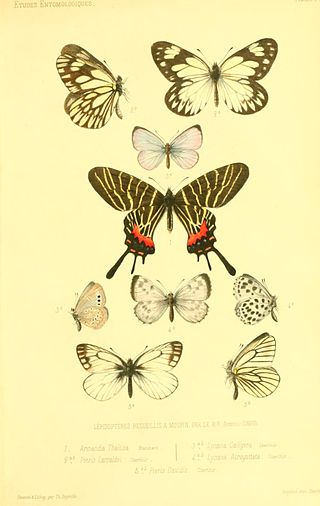
Adenophora is a genus of flowering plants in the family Campanulaceae, the bellflowers. Plants of this genus are known commonly as ladybells. Most of the species in the genus are native to eastern Asia, with a few in Europe. Many are endemic to either China or Siberia.

Byasa polyeuctes, the common windmill, is the most common member in India of the windmills genus (Byasa), comprising tailed black swallowtail butterflies with white spots and red submarginal crescents.

Parnassius epaphus, the common red Apollo, is a high altitude butterfly which is found in India and Nepal. It is a member of the snow Apollo genus (Parnassius) of the swallowtail family (Papilionidae). It is found from 9,000 to 13,000 feet from Chitral District to Sikkim and western regions of Nepal. It is not considered rare.

Aletris, the colicroot, colicweed, crow corn, or unicorn root, is a genus of flowering plants in the family Nartheciaceae, native to North America and to eastern and southeastern Asia, especially China. It was used as a component in Lydia Pinkham's original Vegetable Compound.

Pontia is a genus of pierid butterflies. They are found in the Holarctic, but are rare in Europe and central to eastern North America, and a few species range into the Afrotropics. Several East Asian species once placed here are now more often split off in Sinopieris. Like the closely related genus Pieris, they are commonly called whites.

Parnassius szechenyii is a high-altitude butterfly which is found in western China. It is a member of the snow Apollo genus (Parnassius) of the swallowtail family, Papilionidae. The species was first described by Imre Frivaldszky in 1886.

Colias erate, commonly known as the eastern pale clouded yellow, is a species of butterfly in the family Pieridae. It is found from south-eastern Europe, through Turkey over central Asia up to Japan and Taiwan. To the south, its range stretches to Somalia and Ethiopia. The species was first described by Eugenius Johann Christoph Esper in 1805.
Soroseris is a genus of Asian plants in the tribe Cichorieae within the family Asteraceae.
Nannoglottis is a genus of Asian flowering plants in the family Asteraceae.

Oreorchis is a genus of flowering plants from the orchid family, Orchidaceae. It is native to Asia. Species currently accepted as of June 2014:
- Oreorchis angustataL.O.Williams ex N.Pearce & P.J.Cribb - Sichuan, Yunnan
- Oreorchis aurantiacaP.J.Cribb & N.Pearce - Myanmar
- Oreorchis bilamellataFukuy. - Taiwan
- Oreorchis discigeraW.W.Sm. - Myanmar
- Oreorchis erythrochryseaHand.-Mazz. - Tibet, Sichuan, Yunnan
- Oreorchis fargesiiFinet - Fujian, Gansu, Hubei, Hunan, Shaanxi, Sichuan, Taiwan, Yunnan, Zhejiang
- Oreorchis foliosa(Lindl.) Lindl. - India, Assam, Nepal, Bhutan, Myanmar, Tibet, Sichuan, Taiwan, Yunnan
- Oreorchis itoana(F.Maek.) Perner - Honshu
- Oreorchis micranthaLindl. - Tibet, Taiwan, Assam, India, Bhutan, Nepal, Myanmar
- Oreorchis nanaSchltr. - Sichuan, Yunnan, Hubei
- Oreorchis nepalensisN.Pearce & P.J.Cribb - Nepal, Tibet
- Oreorchis oliganthaSchltr. - Gansu, Sichuan, Tibet, Yunnan
- Oreorchis parvulaSchltr. - Sichuan, Yunnan
- Oreorchis patens(Lindl.) Lindl. - Japan, Korea, Russian Far East, China
- Oreorchis porphyranthesTuyama - Nepal
- Oreorchis sanguinea(N.Pearce & P.J.Cribb) N.Pearce & P.J.Cribb - Bhutan

Ptilagrostis is a genus of grasses in the family Poaceae. They are distributed in Asia and North America. They are known commonly as false needlegrasses.

Biston panterinaria is a moth of the family Geometridae. It is found in China, India, Nepal, Sikkim, Vietnam and Thailand.
Tridrepana rubromarginata is a moth in the family Drepanidae. It was described by John Henry Leech in 1898. It is found in China, India, Bhutan and Nepal.

Sinopieris davidis is a species of butterfly in the genus Sinopieris, but also possibly in Pontia. It was described by Charles Oberthür in 1876 and is found in China.
Sinopieris dubernardi, or Oberthür's white, is a species of butterfly in the family Pieridae. It is treated as a member of the genus Sinopieris, or alternately, the genus Pontia. It is found in China, where it inhabits grassland plateaus and mountainsides at elevations above 2,000 meters.

Calinaga lhatso is a butterfly found in the Palearctic that belongs to the browns family (Nymphalidae). The species was first described by Charles Oberthür in 1893. It is endemic to China.











